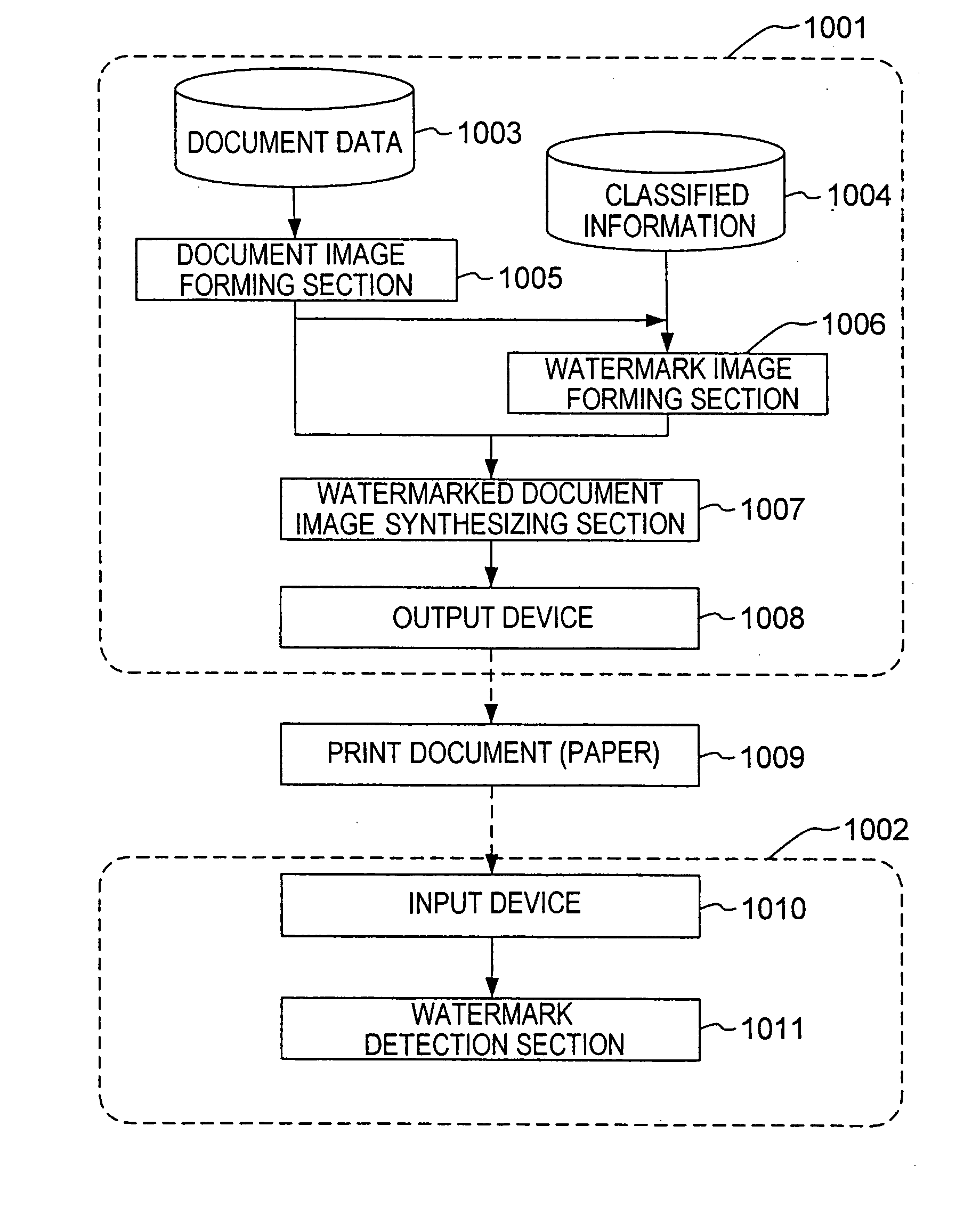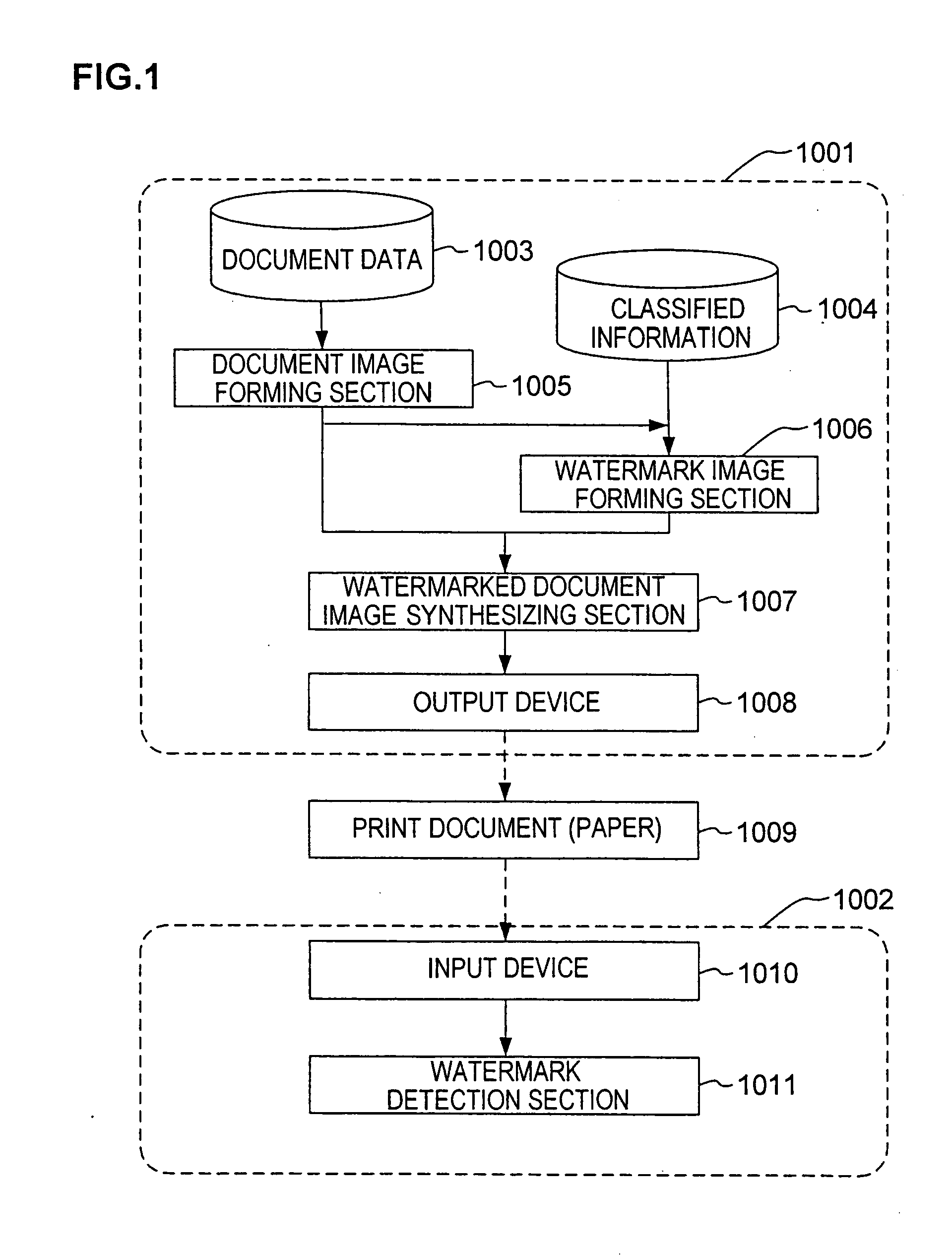Electronic watermark embedding device, electronic watermark detection device, electronic watermark embedding method, and electronic watermark detection method
a technology of electronic watermark and embedding device, applied in the field of electronic watermark embedding/detection technology, can solve the problems of difficult identification of the location of changes and low detection accuracy in cases
- Summary
- Abstract
- Description
- Claims
- Application Information
AI Technical Summary
Benefits of technology
Problems solved by technology
Method used
Image
Examples
first embodiment
(First Embodiment)
FIG. 1 is an explanatory diagram showing the structure of the electronic watermark embedding device and the electronic watermark detection device of the first embodiment of this invention. First, the electronic watermark detection device 1001 will be described.
(Electronic Watermark Embedding Device 1001)
The electronic watermark embedding device 1001 forms document images based on document data 1003 and classified information 1004 which is embedded in the document, and prints it on a paper medium. The document data 1003 is data including font information and layout information, and is data created by document creation tools and the like such as word processing software and the like. Also, the classified information 1004 is information which is embedded in the forms other than text and may be various types of data such as text, image, and sound.
As shown in FIG. 1, the electronic watermark embedding device 1001 comprises the document image forming section 1005, ...
second embodiment
(Second Embodiment)
FIG. 20 is an explanatory diagram showing the structure of the electronic watermark embedding device and the electronic watermark detection device of the second embodiment of this invention. The difference between this and the first embodiment is that, the electronic watermark detection device 2002 also has a text deletion alteration detection section 2012. Here the structure and operation of the electronic watermark embedding device 1001 is the same as that of the first embodiment.
(Text Deletion Alteration Detection Section 2012)
The text deletion alteration detection section 2012 is the portion where the process is carried out for detecting the presence and location of alteration in the case where text portion of the print document 1009 has been altered with by deletion with correction fluid and the like.
FIG. 21 is a flowchart showing the operation of the text deletion alteration detection section.
It is assumed that the alteration is the case where text po...
third embodiment
(Third Embodiment)
FIG. 26 shows the structure of the third embodiment of this invention. The difference between this and the first embodiment is that, the electronic watermark embedding device 3001 also has the embedded signal number recording section 3012, and the electronic watermark detection device 3002 also has the embedded signal number detecting section 3013, the filter output value calculating section 3014, the optimum threshold value determining section 3015, the detection signal counter 3016 and the alter determination section 3017. Here the operation of other structural elements is the same as those of the first embodiment.
(Embedded Signal Number Recording Section 3012)
The embedded signal number recording section 3012 is the section for recording the number of signals embedded in the watermark image in the image itself. This signal number changes depending on the number of characters and layout of the document image of the original text.
(Embedded Signal Number Detec...
PUM
 Login to View More
Login to View More Abstract
Description
Claims
Application Information
 Login to View More
Login to View More - R&D
- Intellectual Property
- Life Sciences
- Materials
- Tech Scout
- Unparalleled Data Quality
- Higher Quality Content
- 60% Fewer Hallucinations
Browse by: Latest US Patents, China's latest patents, Technical Efficacy Thesaurus, Application Domain, Technology Topic, Popular Technical Reports.
© 2025 PatSnap. All rights reserved.Legal|Privacy policy|Modern Slavery Act Transparency Statement|Sitemap|About US| Contact US: help@patsnap.com



